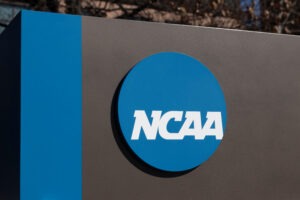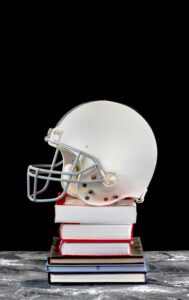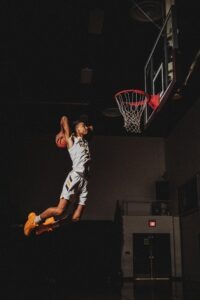Navigating NIL and the “Celebrification” of Student-Athletes
by Hailey Castillo.
In 2009, former UCLA Bruins power forward Ed O’Bannon sued the National Collegiate Athletic Association (NCAA) due to its unfair compensation rules. During his time at UCLA in the 1990s, student-athletes were barred from “receiving any compensation, beyond the value of their athletics scholarships, for the use of their names, images and likeness.”
However, in 2008, NCAA Basketball 09, a video game created by EA Sports, featured a basketball player who played O’Bannon’s position, had his jersey number and looked exactly like him — and he didn’t see a penny from the estimated over $10 million profit.
In 2014, a federal judge ruled that the NCAA’s compensation rules were in violation of antitrust laws, and O’Bannon has since been described as a “key figure in college athletes’ struggle for fairness.” As of 2021, the NCAA now allows college athletes to earn money through name, image and likeness (NIL) agreements, although they cannot be paid solely for their performance on the field or court.

In a previous Platform Magazine blog, Carleigh Clark delved into the opportunities college athletes face when it comes to accepting NIL deals. Not only do college athletes get to build their personal brands, but they also become representatives of the companies they’re promoting. With NIL still being so new, and the NCAA itself questioning how to regulate it, how can universities successfully control image management for the athletes, their teams and the colleges they represent during the era of the “celebrification” of student-athletes?
Education and personal branding
Originally a compliance coordinator, Taylor Jacobs has been the associate athletic director for NIL and strategic initiatives at Louisiana State University (LSU) since July 2022. As someone who has experience as a student-athlete and an influencer, Jacobs hones in on educating student-athletes, coaches, community and staff when it comes to taking NIL opportunities.
According to Jacobs, one of the main components of NIL education at LSU is having brand identity meetings, which are one-on-one conversations with student-athletes. In these meetings, Jacobs asks what’s important to the athlete: “Who are you and what do you stand for? What kind of brands do you want to align yourself with?” From there, she helps challenge athletes to think about who they want to represent, thinking past the monetary value of an opportunity. However, Jacobs said it’s always the athlete’s choice when it comes to accepting a deal.
With the rise of social media and influencer marketing, according to Jacobs, student-athletes have the potential to be micro-influencers. “Ninety-five percent of what’s coming through LSU NIL deal-wise includes at least one social media component because of the ease,” she said. “It’s easy for athletes to sign a deal with a company and create social media posts on their own time.” She argued that although social media has made NIL accessible, it’s still difficult being in an influencer role while being a full-time student and athlete.

Athletes like LSU’s Olivia “Livvy” Dunne, a gymnast with 7.3 million TikTok followers, and Paige Bueckers, a UConn women’s basketball player with one million Instagram followers, have both capitalized off of their name, image and likeness during their collegiate careers, partnering with brands like Vuori Clothing and Crocs. With that said, they have platforms to reach more people than just the collegiate communities they interact with in person or on a day-to-day basis.
On the other hand, Dunne and Bueckers are still students who attend classes and dedicate time to their sports despite making money from NIL deals. Jacobs said that LSU helps with media training for how athletes present themselves on social media. Still, there is room for potential risks and controversies.
“[My department] has all seen some things from a brand perspective, and we’ve seen a brand or business engage in a deal with a student-athlete who the following week got injured and never played again in that season,” Jacobs noted. “That was harmful to the brand. We’ve seen student-athletes engage in some partnerships that might not have been the best look and realizing, ‘I should have thought about this differently.’”
Relationships among the athletes, their universities and the brands they support are important to keep track of — university brands add value to an athlete’s brand value and vice versa. However, an athlete only directly represents a college for a few years.
Jacobs noted that “LSU doesn’t define who [athletes] are; it’s only a piece of [their] story. The social media component — followers and engagement — doesn’t define them.” She emphasized that athletes should balance their roles on social media with the goals they have outside of their universities, including their future careers and how they want to be perceived by employers, if they go down traditional career paths.
Public perception
Dr. Meredith Bagley is an associate professor at The University of Alabama’s College of Communication and Information Sciences and studies the relationship among sport, culture and society. She weighed in on other sides of NIL, including public perception and fan behavior toward student-athletes.

“I’m always interested in ways that we can see student-athletes more as a full well-rounded human than as a body who does outstanding things that makes us feel good about our school winning,” Bagley said. With student-athletes being able to use their celebrity status across different platforms, they can share more about themselves than just their athletic performances, including their own beliefs and opinions on different subjects. Bagley also noted that NIL allows student-athletes to have more power and control over their messages they’re sharing, especially since they aren’t receiving money directly from their universities, so they have more freedom when it comes to free speech.
Still, Bagley argued that the public, like with any situation in life, will probably like some of what they see and not like other things when it comes to NIL. She also alluded to public perception being more affected by human behavior.
“We think [NIL] is going to change stuff, but it just enhances and elevates human patterns that are already in existence,” Bagley said. “We already dehumanize athletes, and I’d argue we’re not very empathetic to people we perceive to have lots of money, or the poor for that matter, either. That’s just something we have to work on as humans.”
Opportunities and advantages
On a more positive note, NIL presents many opportunities for athletes to use NIL to their advantage. Bagley currently resides in Connecticut where she’s working for UA remotely, and she expressed that she’s interested in how NIL will affect the power dynamics of sport, especially from a gendered perspective.

“UConn basketball is so good, and the public and fan base is so in tune to women’s sports in a different way than Alabama in the Deep South,” she said. “It’s a legendary program, and there’s kind of like this collectivism vibe in the UConn women’s basketball community where [the athletes] are sharing and thinking across their team, which is a feminist team sports spirit that we don’t see often.”
Bagley also questioned how activism will play a role with NIL, given that student-athletes can use their social media platforms to be progressive, and what type of organizations and companies will work with these students in their advocacy endeavors. Ashlee Woods of The Crimson White wrote that NIL gives athletes the landscape for activism to exist. “College athletes don’t have to be stars to participate in activism,” Woods said. “Social media allows college athletes to raise awareness for a cause with a simple video or post.”
What’s to come
NIL deals are new to the world of collegiate athletics, and professionals are still trying to figure out how to navigate them. “It’s going a lot faster than a lot of us anticipated,” Jacobs said. “In July 2021, right before the laws passed, we were predicting that what we’re dealing with now was going to be five or six years away.”
While there are a lot of gray areas still being figured out for all the parties — athletes, collegiate athletic directors and brands — Jacobs emphasized that everyone needs to be willing to adapt and pivot to the changes that are continually being updated by the NCAA.
It’s clear that student-athletes are now able to wear many hats, whether they’re selling their own brands, posting sponsored posts for another brand or working with a collective, but NIL is more than just a way to make income. Athletes are able to capitalize off their personal brands more than ever before and have changed the collegiate athletic scene forever.




